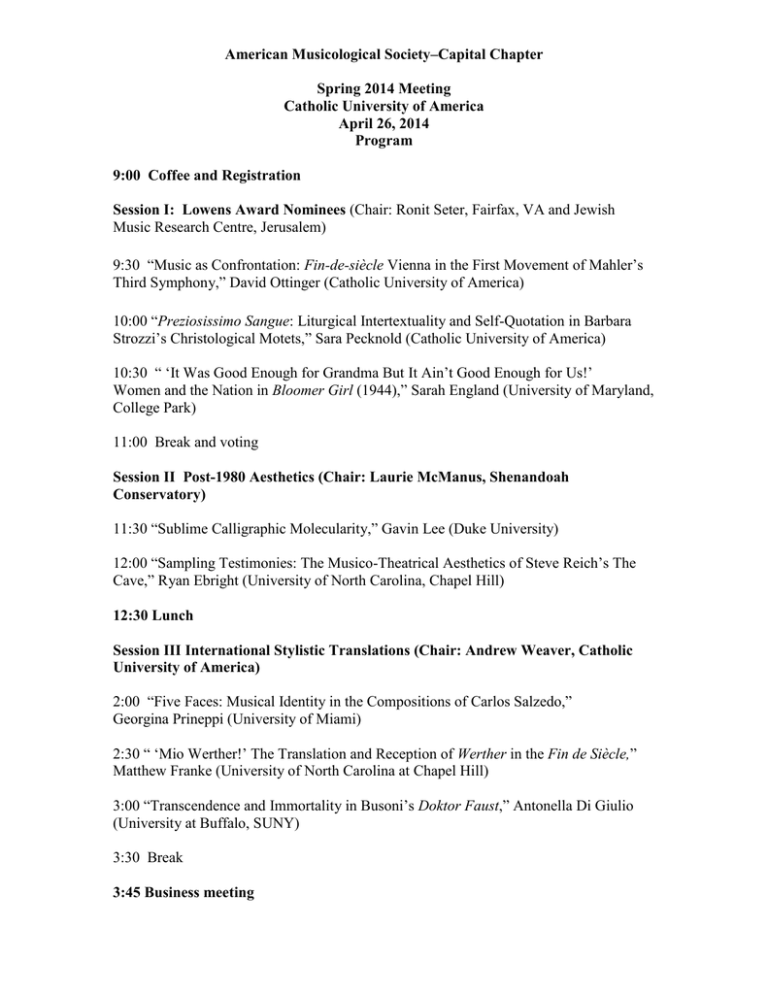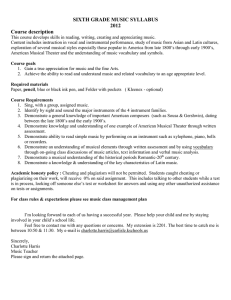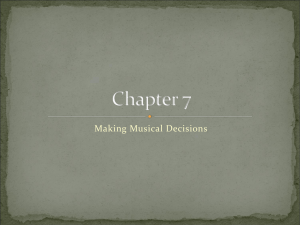Spring - American Musicological Society
advertisement

American Musicological Society–Capital Chapter Spring 2014 Meeting Catholic University of America April 26, 2014 Program 9:00 Coffee and Registration Session I: Lowens Award Nominees (Chair: Ronit Seter, Fairfax, VA and Jewish Music Research Centre, Jerusalem) 9:30 “Music as Confrontation: Fin-de-siècle Vienna in the First Movement of Mahler’s Third Symphony,” David Ottinger (Catholic University of America) 10:00 “Preziosissimo Sangue: Liturgical Intertextuality and Self-Quotation in Barbara Strozzi’s Christological Motets,” Sara Pecknold (Catholic University of America) 10:30 “ ‘It Was Good Enough for Grandma But It Ain’t Good Enough for Us!’ Women and the Nation in Bloomer Girl (1944),” Sarah England (University of Maryland, College Park) 11:00 Break and voting Session II Post-1980 Aesthetics (Chair: Laurie McManus, Shenandoah Conservatory) 11:30 “Sublime Calligraphic Molecularity,” Gavin Lee (Duke University) 12:00 “Sampling Testimonies: The Musico-Theatrical Aesthetics of Steve Reich’s The Cave,” Ryan Ebright (University of North Carolina, Chapel Hill) 12:30 Lunch Session III International Stylistic Translations (Chair: Andrew Weaver, Catholic University of America) 2:00 “Five Faces: Musical Identity in the Compositions of Carlos Salzedo,” Georgina Prineppi (University of Miami) 2:30 “ ‘Mio Werther!’ The Translation and Reception of Werther in the Fin de Siècle,” Matthew Franke (University of North Carolina at Chapel Hill) 3:00 “Transcendence and Immortality in Busoni’s Doktor Faust,” Antonella Di Giulio (University at Buffalo, SUNY) 3:30 Break 3:45 Business meeting AMS-CC Spring 2014 Meeting Paper Abstracts “Music as Confrontation: Fin-de-siècle Vienna in the First Movement of Mahler’s Third Symphony” David Ottinger (Catholic University of America) Throughout Mahler’s oeuvre there is a strong connection between his music and the time and place in which it was composed and performed. Yet, in the case of his Third Symphony, important parallels between his life and the music have been overlooked. The current corpus of research does not include an interpretation of this symphony that analyzes how both the cultural context of fin-de-siècle Vienna and events in Mahler’s own life inform the music. I argue that the program and musical content of the first movement of the symphony are deeply connected with the composer’s past experience in Vienna. Mahler not only references Vienna through musical quotation, in the use of the student protest song Wir hatten gebautet ein stattliches Haus, but depicts musically a dramatic foreshadowing of his imminent return to the city as a conductor. He does so through the manner in which the protest song unfolds and interacts with other material in the symphony. This argument draws upon the work of Julian Johnson in his book Mahler’s Voices, where he describes in detail the ways in which Mahler’s musical lines communicate and interact with one another. By comparing the musical events of the symphony to Mahler’s extensive program notes, I will make clear through a careful reading of the first movement how the Third Symphony challenges Mahler’s critics and serves as triumphant entry music for the composer who, shortly after the completion of this work, achieved his long-desired position as a conductor in the Austro-Hungarian capital. I do not attempt to discredit the interpretation of others, such as those who see a dynamic statement of the whole of Nature or a dramatic Nietzschian-Schopenhauerian philosophical statement. Instead, I believe there exist multiple levels of meaning, one of which addresses the antagonism faced by Mahler and his generation from the predominant cultural institutions in Vienna. “Preziosissimo Sangue: Liturgical Intertextuality and Self-Quotation in Barbara Strozzi’s Christological Motets“ Sara Pecknold (Catholic University of America) On January 1, 1650—the Feast of the Circumcision—Venetian poet Giulio Strozzi wrote his final will and testament. Eschewing typical legal formulae, and rendering the will in a large, scrawling hand, Giulio concluded with a surprisingly earnest supplication: “I recommend [my soul] to God, who created it, and who bought it with his preziosissimo sangue, so that I still hope to see . . . salvation . . . not for my merits, but for His infinite mercy.” Upon Giulio’s death in 1652, the will was opened and read to his adopted (and possibly illegitimate) daughter, the prolific composer Barbara Strozzi. Three years later, Barbara published her only sacred opus for solo voice, the Sacri musicali affetti. In this paper, I will argue that there are connections between Giulio’s will and the Christological motets of the Sacri musicali affetti; in fact, Barbara’s motet to the Name of God suggests a new interpretation of the print itself as a votive offering for Giulio’s soul. Furthermore, I will argue that the Christological motets lend coherence to the entire opus, as it relates to Barbara’s redemptive reading of both her father’s and her own public identities. I will illustrate this by investigating the socio-religious contexts of both the composer and her dedicatee, and the motets’ intertextuality with the liturgies of Corpus Christi and the Nativity of Mary. I will then examine Barbara’s self-quotation of musical material from her motet Mater Anna as the final component of her own supplication for renewal. “‘It Was Good Enough for Grandma But It Ain’t Good Enough for Us!’ Women and the Nation in Bloomer Girl (1944)” Sarah England (University of Maryland) Bloomer Girl (1944) by Harold Arlen (1905–1986) and E.Y. Harburg (1896–1981) was the first book musical to follow in the footsteps of Oklahoma! (1943). Like Oklahoma! the show brought together the elements of music, drama, and dance in the service of a comprehensive whole. When viewed as the successor to Rodgers and Hammerstein’s Oklahoma!, Bloomer Girl appears to owe a substantial debt to its venerable predecessor. In addition to the format and the Americana inspired theme, the two shows also shared a personnel roster. The obvious parallels between Oklahoma! and Bloomer Girl led theater critics and scholars to compare the musicals at the expense of overlooking the contributions the latter made to the genre. Overshadowed by its more famous predecessor, Bloomer Girl has fallen into obscurity. This paper moves Bloomer Girl out from the shadow cast by Oklahoma! and situate it within a rich historical context. Focusing specifically on the feminist themes of Bloomer Girl, I present an analysis of the female character types in the musical, and how they deviate from traditional understandings of femininity as they were depicted on stage in the Golden Age. Through this analysis, it becomes clear that the score functions as an audible metaphor for the breakdown of gender boundaries that occurs within the plot of the musical. Two juxtaposing musical styles–classical and popular–are used to represent conventional and subversive constructions of femininity respectively. The breakdown of gender boundaries in Bloomer Girl creates a surprisingly critical political commentary about the United States during World War II—a commentary that stands in stark contrast to the star-spangled patriotism of the 1940s. While most musicals of the 1940s projected a rose-colored image of the United States that justified America’s involvement in World War II, Bloomer Girl called attention to the problems of prejudice and discrimination on American shores. Our investment in the overarching narrative of the Golden Age musical, however, has allowed Bloomer Girl and its politics to be ignored. This paper shows that an awareness of alternate histories can allow us to better understand the American musical. “Sublime Calligraphic Molecularity” Gavin Lee (Duke University) Writings on the sublime have neglected twentieth century music. This paper proposes anaesthetic investigation of post-1945 styles in terms of the sublime, defined in the Kantian sense of the perception that there is something unperceived. Deleuze’s phenomenology of “molecular” musical modernism as expressed in Varèse is incorporated to invert the cause of sublime un-perception from the massive size or power of the musical phenomenon to its micro “molecularity.” (Molecularity is situated in a dialectic with “molarity,” these scientific terms referring respectively to small and large amounts of matter respectively.) Since molecularity is Deleuze’s privileged term for elucidating his processual philosophy of becoming other than what is, I am able to interpret molecularity in musical phenomenology as that element which is other than fully known—i.e. as the perceptually liminal. The sublime combination of perceptual focus and liminality is an aesthetic trait of complex modernist music. An exemplary instance of the modernist sublime, Singaporean composer Joyce Bee-Tuan Koh’s TAI (2002, BBC Symphony Orchestra, based on the logogram tài - 泰) achieves perceptual liminality through post-spectralist and micropolyphonic techniques. Focused musical expression of Chinese calligraphy strokes near the opening of the piece is later rendered liminal in two ways: 1) the transfer of musical energy emanating from pitch register modulation (e.g., up-down strokes of the brush) to timbral modulation, and 2) the dissipation of energy in the latter mode into micropolyphonic modulation. Furthermore, the initial focused expression of the strokes is already also partially liminal, a facet of perception stemming from the complexity of the score (e.g., an overall downward stroke evincing from glissandi starting on different pitches and at different times). My analysis shows that TAI exhibits sublime calligraphic molecularity. “Sampling Testimonies: The Musico-Theatrical Aesthetics of Steve Reich’s The Cave” Ryan Ebright (University of North Carolina, Chapel Hill) Contemporary American composers, including John Adams and Steve Reich, have relied increasingly on documentary sources in fashioning both staged and non-staged works, such as the former’s On the Transmigrations of Souls and Doctor Atomic and the latter’s City Life and WTC 9/11. The incorporation of documentary material begs questions of what effect and function it has within a musical work. Scholars are just beginning to grapple with these issues; Amy Lynn Wlodarski, for example, has argued that Reich’s purported musical objectivity in Different Trains—the result of his reliance on documents—does not hold up under scrutiny, but instead constitutes a form of what Holocaust scholars term “secondary witness.” With Reich’s work on Different Trains, The Cave, and Three Tales, the question of documentary use is particularly complex, given that the melodies and harmonies are drawn directly from the “documents”—in this case, recorded speech samples. Given the theatrical nature of Reich’s three aforementioned pieces, however, I propose that their documentary nature might best be understood with reference to the tradition of documentary theater, which was experiencing both a resurgence and transformation in the United States during the 1980s and early 1990s when Different Trains and The Cave were created. Over the course of a decade, a “theater of testimony”—derived from oral histories and interviews—began to define American documentary theater. Drawing on archival documents at the Paul Sacher Stiftung and new interviews with The Cave’s creative team, this paper outlines the hermeneutic possibilities and questions posed by approaching The Cave as documentary theater. More so than traditional, spoken documentary theater, The Cave foregrounds the use of media and technology, therefore arguably obviating the need to acknowledge the mediated nature of the theatrical material, as is typical in much spoken documentary theater. At the same time, in the midst of the technological tapestry created by interweaving video and audio samples, the presence of the singers acts as a conduit between authors and audiences, the electronic and the live. “Five Faces: Musical Identity in the Compositions of Carlos Salzedo” Georgina Prineppi (University of Miami) Carlos Salzedo was a multi-faceted musician of the early twentieth century who is primarily remembered as a virtuoso harpist and pianist. However, Salzedo was also a talented composer whose music gained the respect of many of his revered contemporaries, including Maurice Ravel, Edgard Varèse and Henry Cowell. Though his compositional output has been somewhat neglected by modern scholarship, it is an important subject of study, not only because of its beauty and originality, but because it represents a compelling example of the interaction between multiple musical identities within a single compositional style. Salzedo’s Basque heritage, artistic associations, personal aesthetics and musical goals created several distinct compositional identities in his music; these identities evolved and interacted with each other in ever-changing ways during his career, yielding a particularly complex body of compositions. This paper identifies and describes the five musical identities to be found in Salzedo’s music: the composer as 1) a harpist, 2) an innovator, 3) an Impressionist, 4) a Neoclassicist, and 5) a Basque. By examining Salzedo’s musical output in light of his cultural background, experiences, compositional purpose, training, artistic influences, and personal musical tastes, this paper aims to elucidate the five distinct compositional identities of Salzedo and explore the extraordinary ways in which they interact and conflict within his dynamic compositional output. “‘Mio Werther!’ The Translation and Reception of Werther in the Fin de Siècle” Matthew Franke (University of North Carolina at Chapel Hill) Although recent musicological studies have analyzed operatic reception in great detail (Wilson 2007, Kreuzer 2010, Martin 2011), translation rarely plays a major role in discussions of reception, or indeed in any musicological discourse related to opera. The few studies to address translation in an operatic context (Kerman 1957/1965, Porter 1984, Gossett 2006, Minors (ed.) 2013) have chiefly focused either on issues of equivalence or translational practice. The present paper attempts to sketch translation’s significance and applicability to operatic reception across cultural and linguistic boundaries through the example of the Italian translation and reception of Massenet’s Werther, particularly Charlotte’s solo scene in Act III. Translation has a close relationship to operatic reception, as it fundamentally alters the relationship between text and music in an opera. If a translated text is used in an operatic performance, then the reception of that performance is, by default, the reception of the translated text. Extending arguments by Derrida (1985) and Devy (1990), I argue that translated operas are not merely derivative reflections of the original, but rather serve as independent works of art, replacing the original in the target culture. Massenet’s (Italian) Werther is not the same work as Massenet’s (French) Werther; it is designed to meet the needs of a different audience, one which had little knowledge of the French original. The Italian translation of Werther transforms the verbal content, and tone of the original French text of Charlotte’s solo scene. While Massenet’s music remains intact, the Italian translation lends this music new dramatic significance and alters the development of Charlotte as a character in the drama. These changes are directly reflected in the early Italian reception of Acts III and IV and in Italian discussions of Charlotte as an operatic character. Thus, translation can mediate the reception of operas across cultural boundaries, and it provides a powerful lens for analyzing an opera’s cultural significance and its textual and dramatic content. “Transcendence and immortality in Busoni’s Doktor Faust” Antonella Di Giulio (University at Buffalo) The categorization of the many musical and literary works inspired by Faust’s myth is based on their two possible conclusions: Faust ends up in hell or is redeemed and attaints heaven. Busoni’s work is often categorized in terms of the redemptive form. I will analyze a third possibility: during the last part of the twenty-first century, philosophers conceptualized that man’s feelings of unhappiness came from his confinement into a wrong linear conception of time, where everything has a beginning and an end. Therefore, it starts flowing the idea of time as eternal recurrence and of a life that doesn’t end with the death. Scholars tend to ignore the links between Doktor Faust and these thoughts because of Busoni’s explicit denial of such philosophical intentions. I will argue that instead Busoni characterizes Faust as a symbol of the new theories circulating at the beginning of the twentieth century. Even though Faust’s depiction may not be intentional, Busoni summed up all the qualities of Nietzsche’s Übermensch, D’Annunzio’s Superuomo, and Pascoli’s “fanciullino” in his main character. Busoni wrote that an opera is the highest form of artistic expression, where music gives words to the unspoken. Are the missing philosophical intentions then probably in the unspoken words and therefore in the missing music of the final scene? My idea is that even though Busoni’s musical intentions for the finale are lost, his philosophical intentions were present already in the libretto he wrote. Faust discovers his own transcendent power, which is independent from the material universe and yet belongs to the nature’s laws that are beyond God and the evil. Doktor Faust’s attainment of immortality does not pray for divine redemption and wins out over everything: in this opera Faust is neither redeemed nor damned. Faust becomes aware that death is nothing but the means that lead to rebirth: “ich, Faust, ein ewiger Wille.”





